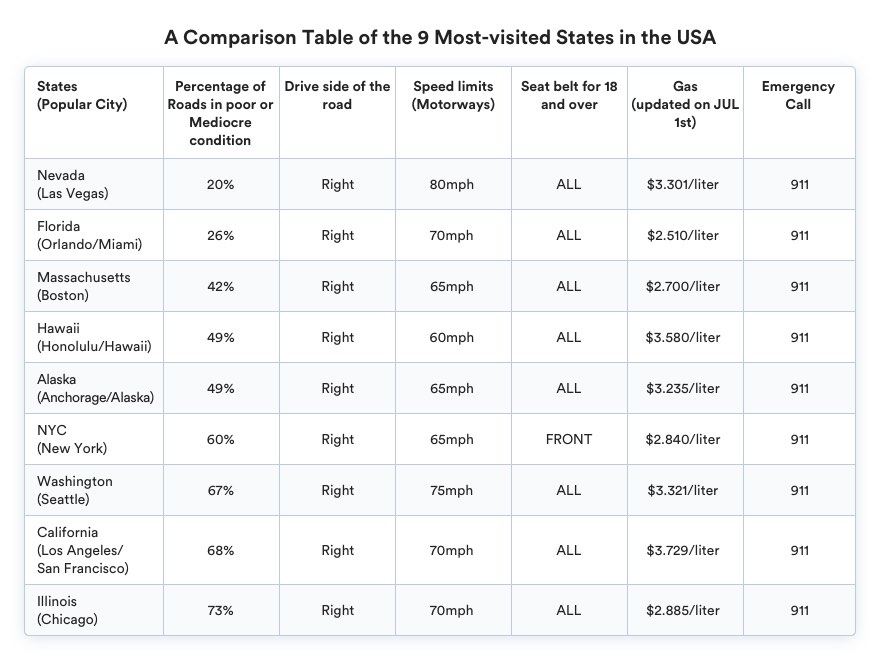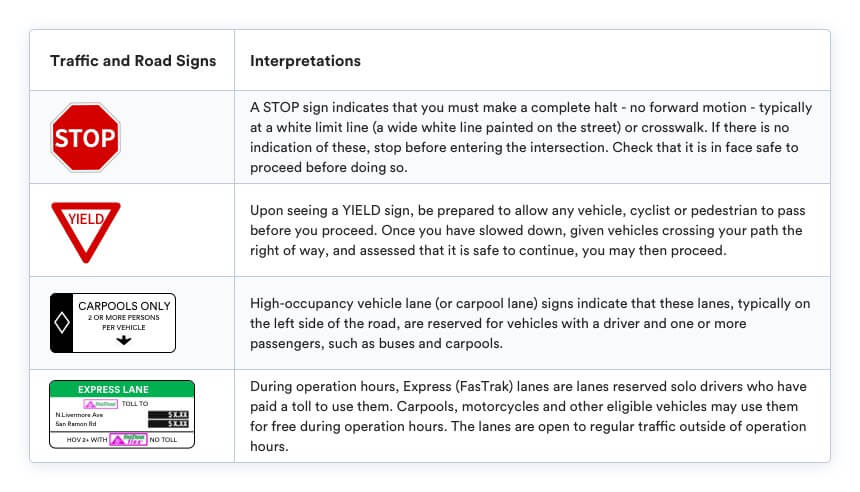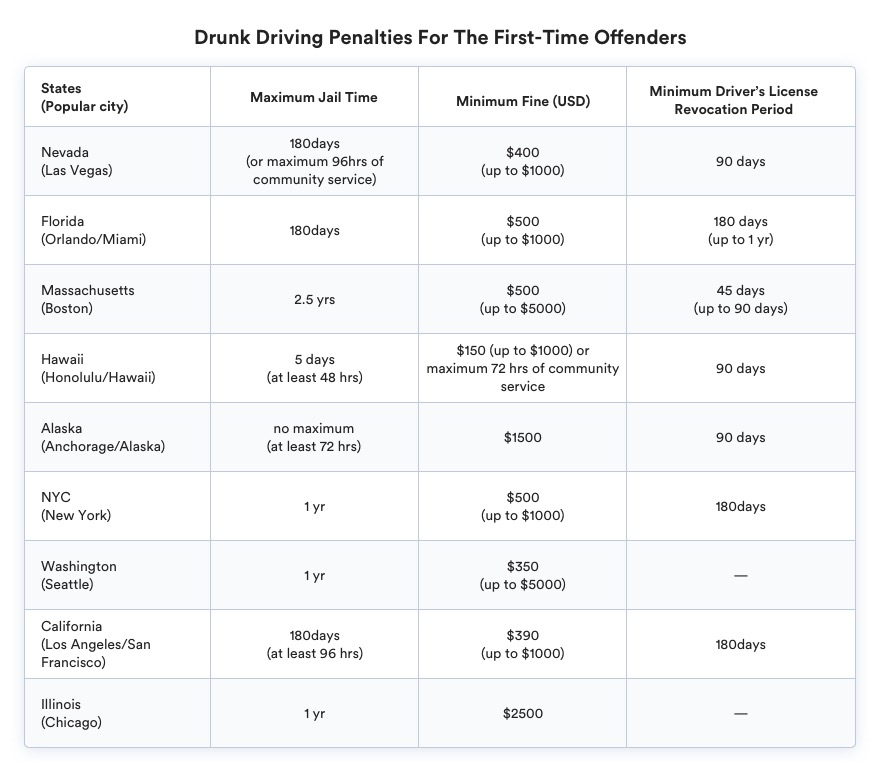Driving is a necessity in the USA – for over a third of the country, the nearest supermarket is over 10 miles away! Further exacerbating the problem is that each state can have different driving laws. This can be confusing for first-time drivers in the USA. The comparison table below highlights the key differences in driving laws among the 9 most-visited states in the USA – take a look!
Download this ebook of driving in the USA and then you can read it on other devices!
There are 4 key areas to be aware of when it comes to driving in the USA: general driving laws and rules, road conditions, petrol type and payment, and parking norms. QEEQ.COM shares all the essentials for safe driving in the USA: what you should do, what you should avoid, and everything in between.
1. USA Driving Rules and Tips
- USA Driving Side
The USA drives on the right-hand side of the road. If you are coming from a country that drives on the left-hand side of the road, exercise greater care when pulling out of one-way streets and maneuvering roundabouts – it will be the opposite of what you’re used to! However, the only exception is the Virgin Islands, which adopts a left-hand drive. Here, you will see signs reminding you to ‘keep left’. Besides, the roads in the Virgin Islands tend to be steep, winding and bumpy – drive at a safe speed when navigating those roads.
Expert tips: Practice, practice, practice! If you are coming from a country that drives on the left-hand side of the road, virtual driving simulators are a fantastic way to condition yourself to left-hand drive in a controlled, stress-free environment!
- Right of Way
When driving in the USA, drivers must yield to the driver on the right. Here are three common examples of giving way:
i. If two drivers reach an intersection at the same time, the driver on the right side has the right of way.
ii. At intersections and marked or unmarked crosswalks, pedestrians have the right of way. However, if a pedestrian crosses a road at a point outside of the marked crosswalk, the vehicles have the right of way.
iii. When 2 vehicles meet head-to-head on narrow, single-lane roads, the vehicle facing upwards has the right of way. The vehicle facing down must back up until the vehicle going uphill can safely pass.
Expert tips: When you are waiting until it is safe to turn left, keep your wheels pointed straight ahead. That way, in the unfortunate case, that another vehicle hits you from behind, you can avoid being pushed into oncoming traffic!
- Speed Limits
Firstly, speed limits and signs are read in miles per hour (mph).
Secondly, speed limits vary from state to state. As such, watch out for speed limit signs, as you will have to adjust your speed when driving between states. Each state has speed cameras set up, so do not go over the allowable speed limit, or you will risk receiving a hefty fine – the most expensive speeding tickets could cost you USD$1,000.
Expert tips: Never go above the allowable speed limit!
- Traffic and Road Signs
For more information about the USA road signs, here is an infographic from QEEQ.COM.
- USA Driving Penalties
i. What to do if you get stopped by the police in the US?
First of all, pull over safely to the side of the road and stay inside the car unless you are told otherwise. And remain calm and polite at all times (NB: your driver’s license and car insurance are needed for inspection – have them ready!).
ii. How to pay driving penalties?
Promptly paying the penalty is strongly advised if you know you have violated a road law, to avoid ending up with a driving record offense. The two penalty payment processes are:
Pay by yourself: Follow the URL on your ticket. The page will instruct you to enter your ticket number and credit card details for payment. Pay the fines promptly to avoid being charged a fee for the late payment of any fines.
Pay by the Rental Company (if you drive a rented car): Notify the car rental desk upon returning the car. They will deduct the penalty amount from your credit card, along with an administration fee.
If you feel that you were over-charged, or received insufficient information regarding your charge, file a complaint immediately, and contest it in a traffic court.
Expert tips: Take note of where all the major traffic violation hot-spots are so that you can take extra precautions, such as lowering your speed, leaving extra space between yourself and the car in front of you. These measures will lower the chances of you committing a driving offense and having to pay a penalty!
- Other USA Driving Tips
i. Don’t drink and drive!
If you plan on drinking, have a designated driver in your group who will not drink, or call a taxi to drive you and your friends home. Penalties on drunk driving are very heavy, as shown in the following table.
ii. Take good care of your children!
Children must be secured in safety seats or booster seats. These seats cannot be placed in the front seat, to prevent them from suffering any harm from deployed airbags.
iii. Beat the jam!
Densely populated cities in the USA such as New York and California are notorious for heavy traffic, so plan to avoid rush hour and peak traffic times.
iv. Never litter!
Throwing litter from your car onto roads is an offense punishable by a fine up to US$1,000.
v. Dial 511 for more information!
Call 511 to require more information about your whereabouts or general travel information.
2. Road Conditions
- Road Conditions
Road infrastructure problems in the USA cause damage to many cars every year. An estimated 20% of roads in Nevada and 26% of roads in Florida are of poor or mediocre condition, while states such as Washington, California, and Illinois reach figures close to and beyond 70%. When traveling in these states, drive at a slower speed and watch out for any imperfections on the road that may damage your vehicle. When braking on unpaved roads, leave extra distance between you and the car in front to avoid rear-ended collisions.
- Toll Roads & e-TAGS
There are fewer toll roads in the western US compared to the east. States in the Northeast, such as Illinois, Ohio and New York, tend to have the most number of toll roads.
How to pay the tolls?
The most common forms of payment are:
i. Electronic Transponder: upon passing through tolls, vehicles equipped with an electronic transponder are automatically detected and the appropriate amount will be deducted.
ii. Self-service coin payment: a coin-operated device will display the amount to be paid. A red light will indicate that the required payable amount has not yet been reached. Upon paying the required amount, a green light will indicate that the vehicle can proceed.
iii. Toll Attendant: this manual form of payment usually costs more than the first forms.
What happens if you fail to pay the toll?
If you accidentally pass through the toll road without paying the fees, simply visit this website within 48 hours, click ‘PAY TOLL NOW’ and follow the steps to pay the fee. If you fail to pay the fee within the 48-hour time frame, you will receive a ticket.
Expert tips: Equip your rental car with an electronic transponder. Check for its availability and fees with your car rental company!
3. Buying Petrol/Gas
Ask your car rental company what type of fuel your car needs. If you have accidentally added the wrong kind of full to your car, contact the fuel station attendant immediately, and carry out a comprehensive inspection of the engine.
How to pay for fuel?
There are two ways to pay for fuel:
i. Self-service payment at the pump
ii. Pay at the fuel station
When using the self-service payment, it is advised that you pay by cash – unless you are an American citizen, your credit card may be rejected as a local zip code is required to complete the transaction. However, if you can pay by credit card, this is the most convenient way to pay for your fuel.
When paying at the fuel station, you can pay by cash or credit card. Find out what their service hours are in advance.
Note: For safety reasons, states including New Jersey and Oregon prohibit self-service payment of fuel. Therefore, fuel station attendants will need to assist you when refueling your vehicles!
Expert tips: The petrol prices vary from state to state. If you are embarking on inter-state travel, plan your journey wisely so that you can refuel your car in the state and fuel stations with the cheaper fuel prices!
4. Parking
To find the perfect parking location at the moment: click here!
To pay for street parking, pay via credit card at the parking meters or payment kiosks found on the side of the streets. For extra convenience, apps like Parkmobile allow you to pay for parking using your smartphone. However, it would be wise to carry coins with you at all times, as some smaller towns use coin meters for parking payment.
Expert tips: Evenings and Sundays are often free of charge, so check on the parking meters before you pay!
Final Thoughts
First of all, make sure safety is your priority. Then, never speed or take unnecessary risks on the road. Moreover, always remember to have cash on hand and keep your driving documents safe with you. With QEEQ.COM’s expert tips under your belt, you are now ready to embark on your driving adventure in the USA!
Visit QEEQ.COM now.
QEEQ.COM guarantees the most competitive car rental deals for your travel and the secret is our Price Drop Protector program! We can automatically track your rental rates and RE-BOOK you if prices drop! See how our customers love this feature here.
Interested in taking a road trip in the USA? Find more about renting a car here:





